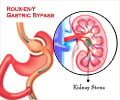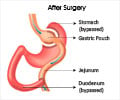Researchers from Stanford School of Medicine had used remote controlled robotic arms and a binocular camera to perform laproscopic gastric bypass surgery successfully. Their research findings are published in the August issue of Archives of Surgery.
The laproscopic gastric bypass surgery (a Roux-en-Y procedure) is often considered the most challenging minimally invasive procedure in general surgery. Although robotic surgical techniques have been developed to assist laproscopic gastric bypass surgery, the complex geometry of the surgery has required repositioning of the robot, complicating its use.Researchers fro the findings reported that the first 10 patients to undergo a totally robotic laproscopic Roux-en-Y gastric bypass surgery (during March and April 2004) using a technique developed to minimize robot repositioning. The results were compared with a sample of 10 patients who had undergone standard laproscopic Roux-en-Y gastric bypass surgery during July to September 2002. There were no significant differences in the general health, age or body mass index (BMI, calculated as weight in kilograms divided by the square of height in meters) of the two sets of patients. All patients were women. The researchers compared surgical times as well as the ratio of the procedure time to the patient’s BMI.
The number and severity of complication were comparable, the researchers found. The rate at which the operative times improved indicate that the learning curve for the robotic procedure is considerably shorter. We found that the mean minutes per BMI of our second five robotic procedures was 3.45 minutes, whereas the laproscopic data for our senior attending surgeon did not attain a comparable five-case mean of the metric until case 42.
Reluctance to use new technology such as the surgical robot often reflects surgeon concern over increasing complication rates, increased operative times, and steep learning curves, the authors conclude.
Source: Newswise











